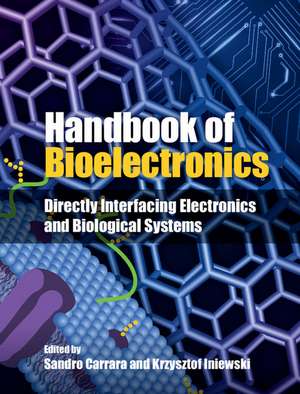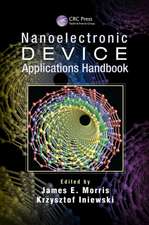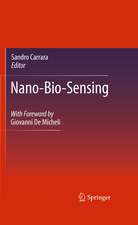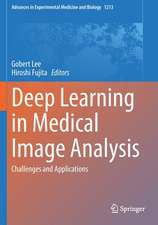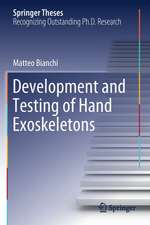Handbook of Bioelectronics: Directly Interfacing Electronics and Biological Systems
Editat de Sandro Carrara, Krzysztof Iniewskien Limba Engleză Hardback – 5 aug 2015
Preț: 2005.30 lei
Preț vechi: 2110.85 lei
-5% Nou
Puncte Express: 3008
Preț estimativ în valută:
383.77€ • 398.64$ • 318.78£
383.77€ • 398.64$ • 318.78£
Carte disponibilă
Livrare economică 11-25 ianuarie 25
Preluare comenzi: 021 569.72.76
Specificații
ISBN-13: 9781107040830
ISBN-10: 1107040833
Pagini: 588
Ilustrații: 470 b/w illus. 33 tables
Dimensiuni: 197 x 253 x 29 mm
Greutate: 1.42 kg
Editura: Cambridge University Press
Colecția Cambridge University Press
Locul publicării:New York, United States
ISBN-10: 1107040833
Pagini: 588
Ilustrații: 470 b/w illus. 33 tables
Dimensiuni: 197 x 253 x 29 mm
Greutate: 1.42 kg
Editura: Cambridge University Press
Colecția Cambridge University Press
Locul publicării:New York, United States
Cuprins
1. What is bioelectronics?; Part I. Electronic Components: 2. Molecular components for electronics; 3. Nano-gaps based devices; 4. Organic thin-film transistors for biological applications; 5. Protein-based transistors; 6. Single molecule bioelectronics; 7. Biomemory device composed of recombinant protein variants; Part II. Biosensors: 8. Biosensors; 9. CNT and proteins for biosensors in personalized therapy; 10. CMOS nanowire biosensing systems; 11. Cell-array biosensors; 12. Pulse radar sensor for contactless respiratory rate monitoring; 13. MagCMOS; 14. Metamorphic neural interfaces with insects for remote controlled biobots; Part III. Fuel Cells: 15. Biological fuel cells; 16. Advances and applications of biofuel cells; 17. Switchable electrodes and biofuel cells logically controlled by chemical and biochemical signals; Part IV. Biomimetic Systems: 18. Biomimetic systems; 19. Epidermial electronics: flexible electronics for biomedical applications; 20. Bioelectronics brain using memristive polymer statistical systems; 21. Electronic design of synthetic genetic networks; Part V. Bionics: 22. Bionics; 23. Bio-electronics interfaces for artificially driven human movements; 24. The bionic eye: a review of multi-electrode arrays; 25. CMOS technologies for retinal prosthesis; 26. Restoration of sight with photovoltaic retinal prosthesis; Part VI. Brain Interfaces: 27. Brain-machine interfaces; 28. ECG technology for the brain-machine interface; 29. Reducing the implant footprint: low-area neural recording; 30. Electrical stimulation; 31. Miniaturized implantable UWB antennas optimized for wireless brain machine interfaces; 32. Intracranial epilepsy monitoring using a wireless neural recording system; 33. Low power building blocks for neural recording systems; 34. CMOS circuits for intracells brain-machine interfaces; Part VII. Lab-on-a-Chip: 35. Lab-on-a-chip; 36. CMOS spectrally-multiplexed FRET contact imaging microsystem for DNA analysis; 37. CMOS electrochemical biosensors: instrumentation and integration; 38. Digital microfluidic biochips: towards hardware/software co-design and cyberphysical system integration; 39. CMOS based biomolecular sensor system-on-chip; Part VIII. Future Perspectives: 40. Future perspective in bioelectronics; 41. Real-time activity energy expenditure estimation for embedded ambulatory systems; 42. Innovative electronic systems for health management; 43. Linking the cyber and the biological world: the ensemble is the function; 44. Conclusion: personal electronics and distributed theragnostics.
Recenzii
'This book, edited by outstanding scientists, will be a great addition to any library, as it provides a valuable source of information regarding bioelectronics-related topics. The topics provided are relevant and timely, and of broad interest for students as well as seasoned scientists.' Ali Khademhosseini, Harvard Medical School
'This work provides real-world applications and even step-by-step design details.' Venkat Subramaniam, Biz India
'This work provides real-world applications and even step-by-step design details.' Venkat Subramaniam, Biz India
Descriere
A wide-ranging view of the state of the art in modern bioelectronics, with real-world examples, step-by-step design details, and insights from experts.
